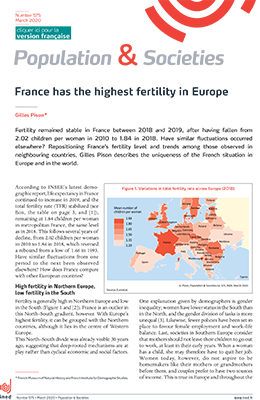France has the highest fertility in Europe
Press release Published on 09 March 2020
Population & Societies no.575, March 2020

Author: Gilles Pison
Fertility remained stable in France between 2018 and 2019, after having fallen from 2.02 children per woman in 2010 to 1.84 in 2018. Have similar fluctuations occurred elsewhere? Repositioning France’s fertility level and trends among those observed in neighbouring countries, Gilles Pison describes the uniqueness of the French situation in Europe and in the world.
Fertility is generally high in Northern Europe and low in the South. One explanation given by demographers is gender inequality; women have lower status in the South than in the North, and the gender division of tasks is more unequal. Likewise, fewer policies have been set in place to favour female employment and work–life balance. Last, societies in Southern Europe consider that mothers should not leave their children to go out to work, at least in their early years. When a woman has a child, she may therefore have to quit her job. Women today, however, do not aspire to be homemakers like their mothers or grandmothers before them. For this reason, couples postpone the birth of a child if they are unable to reconcile work and family life.
In the former communist countries of Central and Eastern Europe, fertility plummeted after the fall of the Berlin Wall in 1989 but has quickly risen over the last few years.
For France, the decrease in the TFR in recent years should be placed in perspective. In the United States, between the start of the crisis in 2007 and 2018, the TFR fell by 23%, from 2.12 children per woman to just 1.73. In the United Kingdom, it fell from 1.96 in 2008 to 1.68 in 2018, a drop of 17%. While France is no exception, the decrease has been much smaller (less than 8% between 2008 and 2018). Despite the recent downturn, the French TFR was still the highest in Europe in 2018. The shock of the crisis and the effects of unemployment were probably dampened by generous social and family policies.
Released on:11/03/2020








